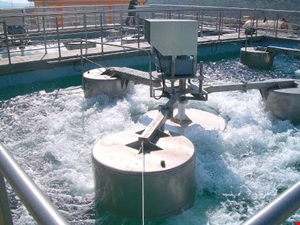PRODUCTs
Leachate Treatment Plant
A
leachate is any liquid that, in the course of passing through matter, extracts
soluble or suspended solids, or any other component of the material through
which it has passed. Leachate is a widely used term in the environmental
sciences where it has the specific meaning of a liquid that has dissolved or
entrained environmentally harmful substances that may then enter the environment.
It is most commonly used in the context of land-filling of putrescible or
industrial waste.
Purpose:
Landfill
leachate treatment is a challenge due to the high and variable concentrations
of dissolved solids, organics, heavy metals and xenobiotic organics.
To
permit evaluators and landfill designers with a tool to rapidly evaluate and
compare the performance of alternatives landfills designs.
The
primary criterion for design of the Leachate Treatment Plant Manufacturer is
that all leachate be collected and removed from the landfill at a rate
sufficient to prevent an unacceptable hydraulic head occurring at any point
over the lining system.
Technology
A
range of technologies are available for the treatment of landfill leachate,
proven in many diverse cases. The following section introduces selected
technologies that have predominantly been employed for landfill leachate
treatment. The highlighted technologies are deployed both as stand-alone
solutions and as part of a process combination. The composition of the landfill
leachate plays a decisive role in selecting the appropriate technology.
Leachate
Treatment Plant
TECHNOLOGY
Biological
treatment
Biological
treatment has proven itself in many cases as a first step in treatment, and is
also useful for nitrogen removal. MBBR, TFR, activated sludge processes,
anammox and loop reactors are deployed. A downstream ultra filtration step is
used in a great deal of cases to deal with sludge arising from biological
processes. If persistent biological compounds remain in the wastewater,
activated carbon filters or ozonisation are employed to remove the
biorefractory contaminants.
Reverse
Osmosis:
The
discharge values obtainable using reverse osmosis is beyond what may be
achieved with any other procedure. The applicability of reverse osmosis is
limited by osmotic pressure, and thus ultimately by the salt content of the
landfill leachate. A high salt content results in very high trans membrane
pressures, and thus requires very large amounts of electrical energy. The presence
of inorganic impurities with encrusting tendencies also limits the
applicability of reverse osmosis. Despite use of anti-scaling reagents, this
often still leads to films accumulating on the membranes, which then require
chemical removal or may even destroy the membranes.
The
concentrate resulting from reverse osmosis must be conveyed for separate
treatment or disposal, which may include the procedures described below. A
growing problem is that although the problematic compounds have been removed
from the water, they are eventually disposed of as waste anyway.
Chemical-Physical
Processes:
Wet
oxidation processes, such as ozonisation, are used if it is possible to oxidize
organic contaminants either completely or to convert biorefractory contaminants
into biodegradable contaminants. Activated carbon adsorption is used for cases
in which organic pollutants in the leachate cannot be degraded either
biologically or using wet oxidation processes. The contaminants are first bound
to the carbon through adsorption and then destroyed by incineration.
Precipitation/flocculation and ion exchange processes are less widespread in
the field of landfill leachate treatment. Both technologies are used to reduce
inorganic ionogenic contaminants.
Methodology
Current
Leachate Treatment Plant for the treatment of leachate mainly consists of
several treatment methods to meet the limiting concentrations for the effluent.
·
Biological
treatment.
·
Flocculation/Precipitation
and Neutralization.
·
Adsorption
(Active carbon).
·
Oxidation
(Ozone + UV).
·
Reverse
osmosis if necessary.
·
Drying.
·
Evaporation.
Features
·
Optimum
waste utilization
·
Economical
to use.
·
Easy
to install and low cost.
·
High
speed processing.
·
Easy
to install and maintain.
Benefits
Leachate
recirculation or bioreactor landfill are increased decomposition rate, lower
Leachate Treatment/disposal costs, and shortened post-closure maintenance
period
The
Leachate Treatment Plant Manufacturer requirements for leachate from landfills
can vary, depending on the discharge requirements, and the contaminants
present. By high TDS, high ammonia, high BOD and/or COD, heavy metals, and
color Leachate from sanitary landfills is generally characterized. Discharge
options include discharge to where no access to sewer is available, or publicly
owned treatment works or discharge to ground or surface water. In the case of
the latter, the requirements of Leachate Treatment Plant are much greater than
when discharge to a POTW is available.
Due to
the high and variable concentrations of dissolved solids, heavy metals,
dissolved and colloidal organics and xenobiotic organics, Landfill Leachate
Treatment is a major engineering challenge. Many different methods were in use
to treat the landfill leachate. Most of these methods are adapted for
wastewater treatment processing and have not yielded satisfactory results for
Leachate Treatment Plant . Due to its varying characteristics and with high
conductivity, leachate is hard to treat by Leachate Treatment Plant with
biological treatment or chemical treatment.
Good
Leachate Treatment Plant is essential for any leachate management system which
features on site Leachate Treatment is to be successful, and the Leachate
Treatment Plant itself cannot work successfully unless the Leachate Treatment
Plant is capable of delivering the leachate to it reliably in the flows needed
to prevent the build-up of leachate within the landfill cells.
The
ability of the Leachate Treatment Plant to deal with variations in the flow and
strength of the leachate is the first requirement to be considered when
embarking on a Leachate Treatment Plant design. This means that a high level of
integration is needed between the Leachate Treatment Plant design and the
Leachate Treatment Plant Manufacturer.

